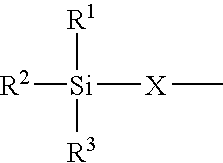Polyisocyanates containing allophanate and silane groups
a technology of allophanate and polyisocyanate, which is applied in the field of polyisocyanates containing allophanate groups and silane groups, can solve the problems of reducing the average isocyanate functionality relative to that of the starting polyisocyanate, drastic increase in the viscosity of the products, and the general use of polyisocyanates containing silane groups in dissolved form
- Summary
- Abstract
- Description
- Claims
- Application Information
AI Technical Summary
Problems solved by technology
Method used
Image
Examples
example 1
Inventive
[0151]1680 g (10.0 mol) of hexaamethylene diisocyanate (HDI) were admixed at a temperature of 80° C. under dry nitrogen with 309 g (1.0 mol) of the hydroxy urethane A1) containing silane groups, and the mixture was stirred for 3 hours until an NCO content of 40.1% was reached, corresponding to complete urethanisation. Subsequently the reaction mixture was heated to 95° C. and 0.5 g of zinc(II) 2-ethyl-1-hexanoate was added as an allophanatization catalyst. The reaction, beginning exothermically, raised the temperature of the mixture to 110° C. After about 30 minutes the NCO content of the reaction mixture was 35.9%, The catalyst was deactivated by addition of 1 g of benzoyl chloride, and the unreacted monomeric RDI was separated off in a thin-film evaporator at a temperature of 130° C. and a pressure of 0.1 mbar. This gave 789 g of a virtually colourless, clear allophanate polyisocyanate having the following characteristics:
NCO content:13.7%Monomeric HDI:0.03%Viscosity (23°...
example 2
Inventive
[0152]In accordance with the process described in Example 1, 1680 g (10.0 mol) of HDI were reacted with 267 g (1.0 mol) of the hydroxy urethane A2) containing silane groups. The allophanatization reaction was initiated at an NCO content of 41.0% by addition of 0.5 g of zinc(II) 2-ethyl-1-hexanoate. On reaching an NCO content of 36.7%, the reaction mixture was stopped with 1 g of benzoyl chloride and worked up as described in Example 1. This gave 690 g of a virtually colourless, clear allophanate polyisocyanate having the following characteristics:
NCO content:14.2%Monomeric HDI:0.06%Viscosity (23° C.):3050 mPasColour number (APHA):19 HazenNCO functionality:>3 (calculated)Silane group content:11.0% (calculated as SiO3;mol. weight = 76 g / mol)
example 3
Comparative, in Analogy to WO 03 / 054049
[0153]660 g (3.61 eq) of a polyisocyanurate polyisocyanate based on HDI, having an NCO content of 23.0% with an NCO functionality of 3.2, a monomeric HDI content of 0.1% and a viscosity at 23° C. of approximately 1200 mPas were admixed under dry nitrogen at a temperature of 100° C., over the course of 30 minutes, with 340 g (1.45 mol) of N-(n-butyl)-3-aminopropyltrimethoxysilane and the mixture was then stirred for 2 hours until an NCO content of 9.1% was reached, corresponding to complete reaction. This gave a polyisocyanate containing silane groups, in the form of a colourless resin of high viscosity having the following characteristics:
NCO content: 9.1%Monomeric HDI:0.03%Viscosity (23° C.):183.000 mPasColour number (APHA):37 HazenNCO functionality:1.9 (calculated)Silane group content:11.0% (calculated as SiO3;mol. weight = 76 g / mol)
PUM
| Property | Measurement | Unit |
|---|---|---|
| temperatures | aaaaa | aaaaa |
| temperatures | aaaaa | aaaaa |
| temperatures | aaaaa | aaaaa |
Abstract
Description
Claims
Application Information
 Login to View More
Login to View More - R&D
- Intellectual Property
- Life Sciences
- Materials
- Tech Scout
- Unparalleled Data Quality
- Higher Quality Content
- 60% Fewer Hallucinations
Browse by: Latest US Patents, China's latest patents, Technical Efficacy Thesaurus, Application Domain, Technology Topic, Popular Technical Reports.
© 2025 PatSnap. All rights reserved.Legal|Privacy policy|Modern Slavery Act Transparency Statement|Sitemap|About US| Contact US: help@patsnap.com



